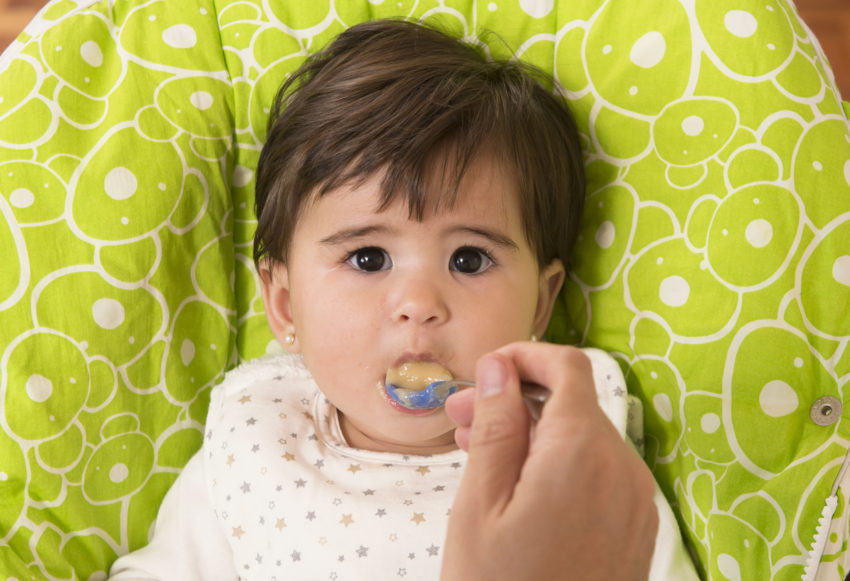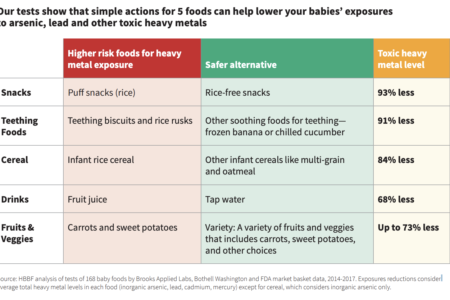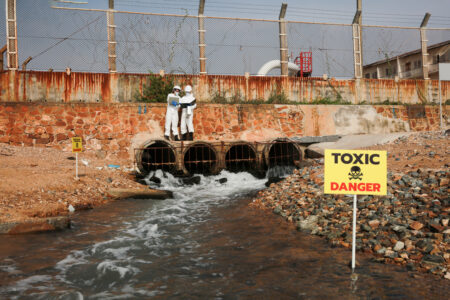
Share On Social!
The vast majority of major baby foods brands contain toxic heavy metals, recent data show.
Of the 168 popular brands tested, 95% contained lead, 73% contained arsenic, 75% contained cadmium, and 32% contained mercury, finds Healthy Babies Bright Futures’ newly published report.
These numbers should be troubling, as even low levels of these kinds of toxins can cause harm as they build up, according to Dr. Philip Landrigan, pediatrician and Director of the Program in Global Public Health and the Common Good in the Schiller Institute for Integrated Science and Society at Boston College.
“Arsenic, lead, and other heavy metals are known causes of neurodevelopmental harm,” Landrigan said. “Low-level exposures add up, and exposures in early life are especially dangerous. The cumulative impact of exposures is what makes this a significant concern that demands action.”
What Did the Study Find in Baby Food?
Most concerning, the report discovered that one in five tested brands contained over 10 times the acceptable 1-ppb levels of lead.
Health officials agree that no amount of lead is safe in babies and children. 
The report goes on to show that rice-based foods, products containing sweet potatoes, and fruit juices contained the highest levels of toxins.
“Our research substantiates the widespread presence of toxic heavy metals in baby foods found in prior studies, almost no enforceable limits or guidelines on what’s allowed, and the common occurrence of arsenic and lead in excess of recommended levels to protect children’s Health,” the report states.
“Although many foods are contaminated, a few stand out: 15 foods consumed by children under 2 years of age account for 55 percent of the risk to babies’ brains. These include apple and grape juice, oat ring cereal, macaroni and cheese, puff snacks, and 10 other foods.”
While these numbers are staggering, experts say there are numerous ways to reduce exposure in homes significantly.
How Can I Keep My Baby Safe from Heavy Metals?
Luckily, Healthy Babies Better Futures and other experts recommend multiple steps that parents can take to ensure their baby is safe from these toxic substances.
Most importantly, limiting a child’s exposure to harmful metals by feeding them alternative food choices, according to Tanya Altmann, a pediatrician and author of “What to Feed Your Baby.”
“Best first foods for infants are avocado, pureed veggies, peanut-butter oatmeal, and salmon,” Altmann said. “They all provide important nutrients that babies need, help develop their taste buds to prefer healthy food, and may decrease food allergies.”
Moreover, policy changes are needed at all regulatory levels, federal agencies especially, states Jane Houlihan, one of the study’s authors and research director for Healthy Babies Better Futures.
“When FDA acts, companies respond. We need the FDA to use their authority more effectively, and much more quickly, to reduce toxic heavy metals in baby foods,” Houlihan said in a statement.
Despite the significant number of concerns that need addressing, there is no time left to lose, according to Charlotte Brody, National Director of Healthy Babies Better Futures.
“No amount of these contaminants is considered safe, but less is better,” Brody said. “HBBF has given parents five simple steps to take, making it easy to reduce children’s exposures to dietary sources of heavy metals until the FDA steps up to set meaningful safety standards.”
Learn more about child and maternal health!
This article is part of a collaboration between Salud America! and the Hoffman Toxicant-Induced Loss of Tolerance (TILT) program at UT Health- San Antonio. To find out if you are TILTed due to exposure to everyday foods, chemicals, or drugs, take a self-assessment or learn more about TILT.
Explore More:
Chemical & Toxic ExposureBy The Numbers
142
Percent
Expected rise in Latino cancer cases in coming years



